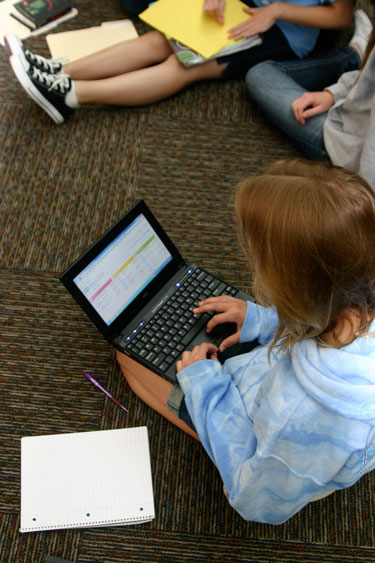It’s not your typical seventh-grade English class: Some kids sit at tables in a classroom, while others lie or sit nearby on an area of carpet, working on assignments on their netbook computers. At the school’s entrance, large flat-screen TVs show instructive videos, including some produced by students. Solar panels in a courtyard provide energy and give pupils the chance to see how the technology works. In a hallway, students can look up information or play games on the many iPads attached to the wall.
“We want it to be an environment where kids enjoy coming to school,” Principal Carrie Jackson said.
This is Timberview Middle School in Keller, one of the few public junior highs in the country built to a green, high-tech, open design, suited for a more creative and collaborative approach to learning. Students often work in small groups, using computers and helping each other figure out assignments. Others work alone. Instead of traditional desks, the kids use wheeled tables that can be rolled around in a classroom or pushed out into the hallway for group study sessions. Students sitting at individual desks in straight rows, facing a teacher and chalkboards, aren’t part of the equation.
If this all sounds like some kind of educational nirvana, don’t say that to the Keller residents whose children have struggled through the school’s inaugural year.
“Our kids are the guinea pigs,” said a disgruntled dad who asked that his name be withheld. Administrators “hadn’t thought through a lot of aspects of the school,” he said. Like others, he had started the school year intrigued by the new campus but now wonders whether his kid is getting shortchanged.
“The idea of the school is great, but the execution has been missed by a mile,” he said.
Parents complain that there is too little teaching going on in the school and too much reliance on the idea of kids looking up information on the internet and, in the end, having to teach themselves and one another.
Some parents are so upset that they have pulled their kids out of the school; at least one family has gone so far as to sell their home to move to another attendance zone.
Many of the school’s 900-plus students live in the nearby Crawford Farms subdivision. Tiffany Sheppard, president of the Crawford Farms Homeowners Association, said the neighborhood’s parents are almost universally disappointed.
“I’ve only talked to one parent who is happy with it,” she said. That father, she said, believes that parents who don’t understand what’s going on “are not using the web site and the teacher blogs.”
Assignments can be viewed online from home or school. Helping a Timberview student with homework often involves getting online. Parents find that paper assignments and textbooks aren’t used much, although school officials said textbooks are available. (During a recent visit to the school there were stacks of math textbooks on the kids’ tables.)
Parents complain about the school’s disorganized opening, technical glitches, and new-wave teaching methods that emphasize self-motivation over teacher interaction. Some said their children’s grades have plummeted.
“One of our previous [neighborhood] board members sold his house so his kids didn’t have to go there,” Sheppard said. “I’m grateful my kids aren’t in there for the experimental year.” She and others say they’ve heard of more families moving away, though no one knows how many.
Timberview doesn’t keep records on families that have sold their houses, but school records do show that at least seven students transferred out with the stated reason that they were unhappy with the school.
It could take quite a while for routines at the school to settle down. Jackson estimated it might be three years before it’s running on all cylinders.
Construction workers struggled to get the school finished in time because of weather issues in 2010. Some of the high-tech equipment didn’t work properly at the beginning of the school year. Other equipment still hasn’t been delivered because of vendor problems. Teachers who were tech-savvy had little problem at the outset, but others took more time to catch on, said the school district’s chief technology officer, Joe Griffin.
“I’ve been out there enough to know there are concerns” among parents, he said. “In the very beginning we were a little bit slow to get things set up because it was a new kind of a system. It wasn’t 100 percent on day one.”
Students didn’t get much schoolwork done while vendors and Griffin’s crews scrambled to resolve technical glitches. Once some kinks were worked out, students began using the high-tech equipment they’d been promised, but some struggled to adapt.
Last week, Timberview’s students — in fifth through eighth grades — took the TAKS tests. Those scores will determine what kind of rating the school receives. Teachers have been drilled over the years that they need to get high TAKS scores from their students so the school can get that all-important “exemplary” or “recognized” school rating. Jackson doesn’t seem too worried.
“There is more to school life than just one state assessment,” she said.
Keller school district officials support the grand experiment, and they’ve integrated similar high-tech teaching methods in several other schools. Timberview is the only building specifically designed with the new concept in mind.
One woman who asked for anonymity said her stepdaughter went from making straight A’s last year to barely passing this year. The girl didn’t adapt well to the concept of working in small groups, with students helping students, rather than getting a more traditional lesson from a teacher.
“It’s this self-motivational learning, and I think fifth grade is too early to force kids to learn for themselves,” the woman said. “She would bring her math homework home, and we had no text to work with. I got on my computer and would Google the problems she was doing. You had to figure it out on your own.”
Her stepdaughter complained that she wasn’t getting enough face time with her teacher. The group she was assigned to work with included two kids who weren’t as smart or motivated as she is, and the group’s work affected her grades.
“It was her and one other girl trying to do all the work for the other people,” the parent said. “She was complaining about the lazy people in her group, and she felt like she wasn’t learning anything. I think she shut down after a while.”
After the fall semester ended, the stepdaughter moved in with her birth mother so she could attend a different school, and her grades went up again.
It’s a frustrating quandary for parents who moved to Keller specifically because of the school system with high graduation rates and a lot of exemplary-rated campuses.
“In theory, the way they have that school set up could work very well, but they didn’t do any of the necessary prep work with the kids,” a parent said. “They didn’t teach the kids time management skills and didn’t teach them how to study in this new way without textbooks, lockers, and desks. They just threw them into it.”
Jackson said the new concept is a student-centered approach like that used in college classrooms. “Education is one of the most difficult institutions to change,” she said.
Last week a group of seventh-graders sat on the floor in an area set aside for students to work together, talking quietly about their assignments.
One student, Victoria, said she was a big fan of the new school with the focus on high-tech gadgets like the laptop she was using.
“I like it,” she said. “You get to experience different ways of doing stuff. You can use different apps, like Inspiration and Excel. It’s more fun than just doing it on paper.”











